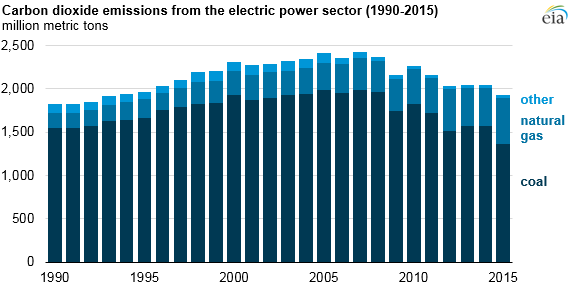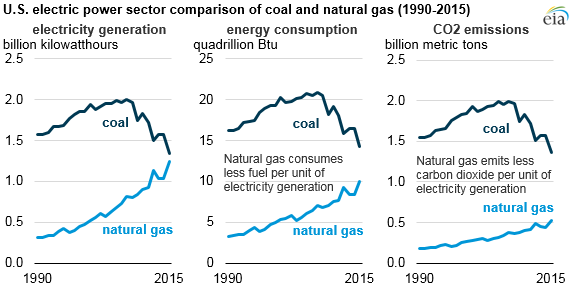Natural Gas: the environmental movement’s strongest asset
Double benefits of gas-fired power plants: NatGas emits less carbon dioxide per unit of electricity generation and consumes less fuel per unit of generation
It shouldn’t be very long before the environmental movement is rallying kayakers to hold celebrations to thank U.S. E&P companies for their hard work and massive investments to find and extract the natural gas that is powering America. Or maybe they will hold a rally to encourage oil companies to go after Alaska’s vast supplies of natural gas, build a pipeline and ship the gas to the lower 48 states to fuel power plants. Meantime they can thank the power companies who have been replacing coal fired generation with electric power that is fueled by natural gas—the single most important factor in the U.S.’s strong record of reducing carbon dioxide emissions.
According to a recent EIA update, carbon dioxide (CO2) emissions from electricity generation totaled 1,925 million metric tons in 2015, the lowest since 1993 and was 21% below their 2005 level. On May 9th, the EIA reported CO2 levels were 12% below 2005.
A shift on the electricity generation mix, with generation from natural gas and renewables displacing coal-fired power, drove the reductions in emissions, the EIA confirmed. However the natural gas fueled plants accounted for the largest share since natural gas is used for baseload power, which is impossible for intermittent sources such as wind and solar.
Total carbon dioxide emissions from the electric power sector declined even as demand for electricity remained relatively flat over the previous decade. In both 2013 and 2014, total electricity sales and electricity-related CO2 emissions increased. But in 2015, both sales and emissions fell. In 2015, warm winter temperatures reduced the demand for electricity, lessened the need to bring marginal generators online, and lowered natural gas prices.
The switch to NatGas is accelerating: during seven months of 2015, electricity generated from natural gas exceeded coal generation.
Electricity generation and its resulting emissions are primarily determined by the available capacity and relative operating costs of the different technologies. Recent capacity additions have favored natural gas and renewable energy, while retirements have been mostly coal units. In recent years, the drop in natural gas prices, coupled with highly efficient natural gas-fired combined-cycle technology, made natural gas an attractive choice to serve baseload demand previously met by coal-fired generation. Coal-fired generation has decreased because of both the economics driven by cost per kilowatthour compared to that of natural gas and because of the effects of increased regulation on air emissions.
Recent shifts in the electricity generation mix have implications for both total energy consumption and energy-related CO2 emissions. Coal plants tend to have relatively low thermal efficiency compared to plants using combined-cycle technology fueled by natural gas. Although there is some variation across individual plants, in general a coal plant consumes more energy than a combined-cycle natural gas plant to produce the same amount of electricity. Also, coal’s carbon content per unit of energy is nearly twice that of natural gas. Considering both the higher thermal efficiency of generators and lower carbon content of fuels, electricity generation using natural gas emits roughly 40% of the carbon dioxide that would be emitted from a coal-fired unit producing the same amount of electricity.
Non OECD Countries Responsible for Carbon Emissions Growth: EIA
The EIA put out a news item today stating that global energy-related carbon dioxide (CO2) emissions are projected to increase by one-third between 2012 and 2040 in EIA’s International Energy Outlook 2016 (IEO2016) Reference case, largely driven by increased energy use in countries outside of the Organization for Economic Cooperation and Development (OECD).




